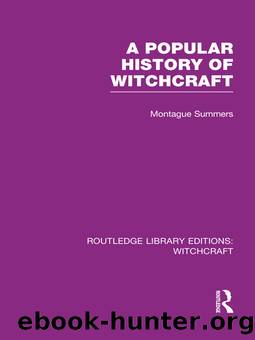A Popular History of Witchcraft (RLE Witchcraft) by Montague Summers

Author:Montague Summers [Summers, Montague]
Language: eng
Format: epub
Tags: History, General, Social History, Reference
ISBN: 9781136740183
Google: C9Q9kzcpkt8C
Publisher: Routledge
Published: 2012-05-23T15:53:50+00:00
âThese confessions made the King [James I, then James VI of Scotland] in a wonderful admiration, and he sent for the said Geillis Duncan, who, upon the like trump, did play the said dance before the Kingâs Majesty.â
The Capuchin Jacques DâAutun in his encyclopaedic treatise on magic (The Folly of the Wise and the Wisdom of the Simple) speaks of sorcerers who gyrate hand in hand in a circle as if inspired by maniac frenzy. He further remarks that whereas a dance should be distinguished by propriety and decorum, by a certain stateliness or it may be by lively frolic, the dances of witches are uncouth and ugly, extravagant and lewd. Such are the dances of savages, and it is worth remark that among the North American Indians there is but one word to express both dancing and coitus. Meanwhile the whole company are whooping and howling, hissing and yelling, in an access of horrid rage that is akin to an absolute frenzy.
There is evidence that various instruments accompanied the dance. Violins, flutes, tambourines, citterns, hautboys, and in Scotland the pipes made music at the Sabbat. Those of the witches who had any skill were called upon to perform, and very often they obliged the company with favourite airs of a vulgar kind, but the concert always ended in hideous cacophony and bestial clamour. In North Italy the covens were wont to âsing in honour of the devil the most obscene songs to the sound of a bawdy pipe and tabor played by one seated in the fork of a tree George Sinclar in his Satanâs Invisible World Discovered says: âA reverend Minister told me, that one who was the Devils Piper, a wizzard confest to him, that at a Ball of dancing, the Foul spirit taught him a Baudy song to sing and play, as it were this night, and ere two days past all the Lads and Lasses of the town were lilting it throw the street. It were abomination to rehearse it.â At Tranent in 1659 one man witch and eight women witches confessed that they had merry meetings with Satan, enlivened with music and dancing. John Douglas, the warlock, was the piper, and the two favourite airs of the Grand Master were âKilt thy coat, Maggie, and come thy way with meâ, and âHulie the bed will faââ.
At Aix the witches danced âat the sound of Viols and other instruments, which are brought thither by those that were skilled to play upon themâ. None the less the sorcerers and hags joined in a kind of howling music with raucous cries imitating song. The Somerset witches of the Wincanton covens said that âThe Man in black, sometimes playes on a Pipe or Cittern, and the company danceâ.
The music in fine was of many kinds, varying from harmonies âsoftly sweet, in Lydian measuresâ, voluptuous and venereal, to the most horrid cacophony resembling the modern jazz, wherein (be it noted) some acute observers have shrewdly scented the devilâs own orchestra.
Download
This site does not store any files on its server. We only index and link to content provided by other sites. Please contact the content providers to delete copyright contents if any and email us, we'll remove relevant links or contents immediately.
| Paganism | Wicca |
| Witchcraft |
Tools of Titans by Timothy Ferriss(7825)
Crystal Healing for Women by Mariah K. Lyons(7718)
The Witchcraft of Salem Village by Shirley Jackson(7044)
Inner Engineering: A Yogi's Guide to Joy by Sadhguru(6449)
The Four Agreements by Don Miguel Ruiz(6324)
The Power of Now: A Guide to Spiritual Enlightenment by Eckhart Tolle(5347)
Secrets of Antigravity Propulsion: Tesla, UFOs, and Classified Aerospace Technology by Ph.D. Paul A. Laviolette(5002)
The Wisdom of Sundays by Oprah Winfrey(4955)
Room 212 by Kate Stewart(4742)
Pale Blue Dot by Carl Sagan(4628)
Fear by Osho(4496)
The David Icke Guide to the Global Conspiracy (and how to end it) by David Icke(4386)
Rising Strong by Brene Brown(4195)
Animal Frequency by Melissa Alvarez(4159)
How to Change Your Mind by Michael Pollan(4115)
Sigil Witchery by Laura Tempest Zakroff(4033)
Real Magic by Dean Radin PhD(3928)
The Art of Happiness by The Dalai Lama(3851)
Man and His Symbols by Carl Gustav Jung(3847)
